Rocket Mass Heater: A Sustainable Heating Solution
- October 30, 2023
- 10 comment
In the world of sustainable heating systems, the Rocket Mass Heater stands as a beacon of innovation and efficiency. It was conceived from the foundational principles of the rocket stove – an invention designed in the late 80’s and early 90’s for developing nations. The aim was simple: reduce fuel consumption and minimize smoke emissions. However, the Rocket Mass Heater took these principles to a new level, blending them with the attributes of a masonry heater but with enhanced accessibility and efficiency.
Origins of the Name

The intriguing name “Rocket Mass Heater” finds its roots in the ingenious invention of the rocket stove, which was developed by Aprovecho for culinary purposes and unveiled to the world in 1982. As the term suggests, “mass” is indicative of the heavy masonry structure that plays a pivotal role in storing heat. Masonry heaters are no novel concept; these heating systems have graced human civilizations since prehistoric times. As time advanced, their designs underwent transformations, adopting and reflecting the architectural and functional nuances of European, Russian, and Chinese cultures.
The cornerstone of these heaters remains consistent: the incorporation of an expansive thermal mass, primarily made of masonry. This structure is adept at capturing and storing heat emanating from the combustion of fuel. The meticulous design channels the exhaust from the combustion process through a winding, serpentine path within the masonry, optimizing heat absorption.
Innovation in the 1980s: The Birth of the Rocket Mass Heater
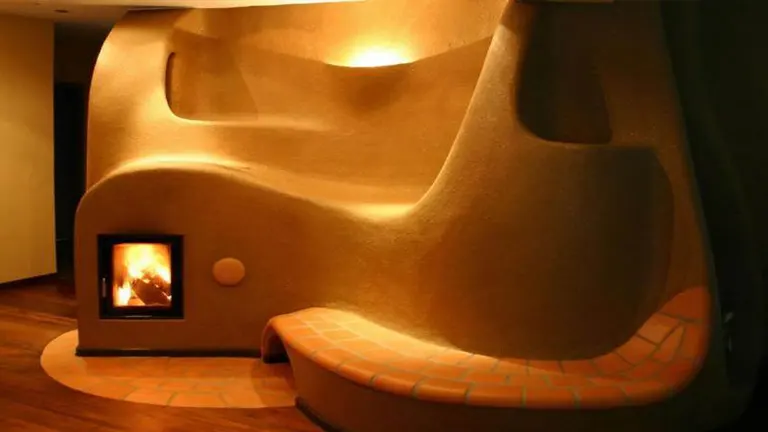
Come the 1980s, the heating world witnessed the advent of the Rocket Mass Heater prototype. While, at first glance, it might appear as a mere offshoot of the traditional masonry heater, the Rocket Mass Heater boasts distinctive attributes that set it apart:
- Immediate Radiant Heat: One of the most pronounced differences is the Rocket Mass Heater’s ability to produce instantaneous radiant heat. This feature can be attributed to the incorporation of the metal “burn” barrel within its design.
- Economical Construction: In stark contrast to its traditional counterpart, the Rocket Mass Heater offers a cost-efficient construction alternative. The choice of materials leans towards affordability without compromising efficiency. Predominantly, the construction employs cob (a composite of clay, sand, straw, and water), complemented by a 55-gallon steel drum and a petite brick firebox.
- Adaptable Foundation Requirements: The design of the Rocket Mass Heater bears the hallmark of adaptability. Unlike the conventional masonry heaters that necessitate a sturdy base, the weight of a Rocket Mass Heater is more evenly dispersed. This dispersal translates to a decreased need for a heavily reinforced foundation, offering more flexibility in terms of installation locations.
Understanding Efficiency and Design

Rocket Mass Heaters stand apart with their innovative structure and unparalleled efficiency. Delving into their anatomy:
- The system begins with a gravity-fed vertical wood chamber that funnels into an “L or J-shaped” horizontal burn chamber, where primary combustion occurs.
- This then channels the hot gases to an insulated secondary burn chamber, equipped with a metal barrel or cylinder. This chamber radiates direct heat, capitalizing on the high-heat, oxygen-rich environment. This design choice results in an incredibly clean combustion, with minimal smoke emissions after the initial burning phase.
- Finally, the hot gases flow through a massive thermal storage system. This thermal mass not only absorbs and holds onto the heat but also releases it gradually, sometimes over several days. It’s not just a functional feature; it often integrates seamlessly into the very architecture of a building.
Now, the efficiency aspect:
- Fuel Consumption: Rocket Mass Heaters are economical giants, consuming up to 80% less wood than many of their traditional counterparts.
- Clean and Turbulent Combustion: Their unique combustion chamber, with its J or L shape, ensures the fire burns horizontally. This causes turbulence that promotes secondary combustion, ensuring a thorough, hotter, and cleaner burn than many other heaters.
Exploring the Diversity of Rocket Mass Heaters
Rocket mass heaters (RMHs) have established themselves as a favorite among those seeking efficient, sustainable, and eco-friendly heating solutions. Their unique designs harness the power of internally insulated chimneys, known as “heat risers”, to achieve a high-temperature burn. This efficient burn creates the necessary draft to circulate exhaust gases through the system, and the flue gases are subsequently cooled in the thermal store. Some designs even condense steam within these gases into liquid, unleashing the latent heat of condensation and enhancing efficiency akin to a condensing (gas) boiler.
While the underlying principle of RMHs remains consistent, the design variations cater to different needs and preferences. Let’s delve into the prominent types:
J-tube Style Rocket Mass Heater
The J-tube style is one of the earliest and most prevalent forms of rocket mass heaters. In this design, wood is gravity-fed into a distinctive “J-shaped” combustion tube. From this chamber, the hot gases then progress to a well-insulated firebrick or ceramic refractory vertical secondary combustion chamber. The subsequent exhaust gases traverse through horizontal metal ducting that’s deeply embedded within a substantial thermal store. This store has the capability to retain heat for extended durations and often forms an integral part of the building’s structure. J-tube style rocket mass heaters have found widespread use in natural constructions and permaculture designs. They are frequently self-constructed and have received recognition from various building codes that govern the blueprint and construction of heating systems in edifices.
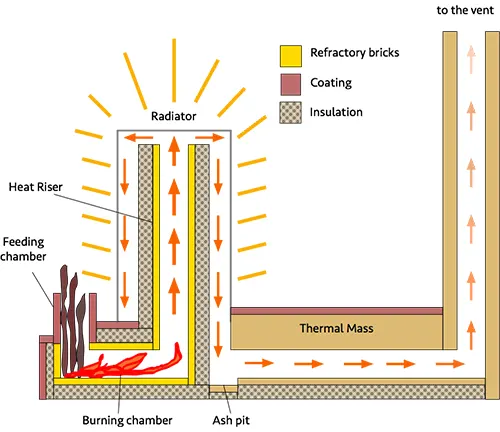
Batch-box Style Rocket Mass Heater
Emerging as an alternative to the traditional J-tube design is the batch-box style. This design incorporates a batch-fed horizontal firebox, which ushers the hot gases into either a vertical heat riser or a secondary combustion chamber. A distinguishing feature of the batch-box style is its ability to accommodate a more considerable volume of wood at once, allowing it to function autonomously for longer intervals. Some iterations of this design replace the conventional horizontal duct flow with a larger “bell” structure, enabling the hot gases to decelerate and stratify, with the cooler gases making an exit near the bottom. An essential aspect of this design is ensuring unobstructed airflow, particularly at the vertical port located at the rear of the box. Constructing a batch-box-style rocket mass heater can be slightly more time-consuming than its J-tube counterpart.
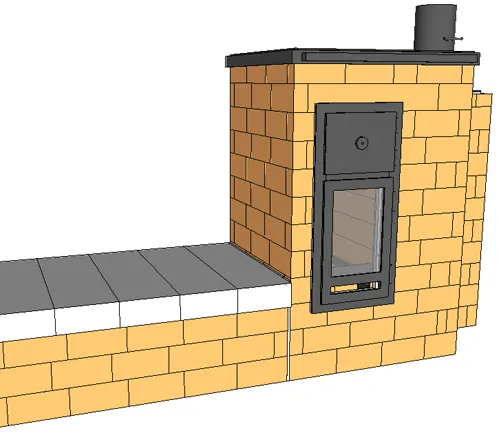
Cob Style Rocket Mass Heater
The Cob-style rocket mass heater introduces a unique element in its construction: a heat riser made of cob. This material is an amalgamation of clay and sand, fortified with straw. Cob’s natural properties of low thermal conductivity make it an excellent medium for absorbing and retaining heat, often for several days after the cessation of the fire. This extended heat retention not only ensures sustained warmth but also results in significant wood conservation.
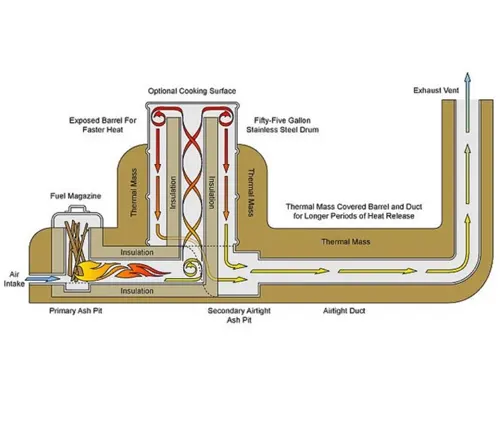
Pebble Style Rocket Mass Heater
The pebble style, conceived by Paul Wheaton in 2010, stands out in its use of pebbles and rocks to facilitate its thermal mass. A standout feature of this design is its reduced weight, making it notably portable. This lightness in design means it can easily be relocated, and modified, and is especially apt for installations on wooden floors. Beyond its functional attributes, the pebble core introduces an aesthetic deviation from the more traditional cob design, offering users an alternative visual appeal.
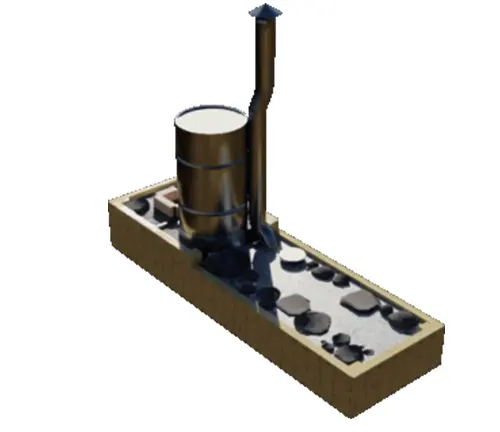
Essential Components of Rocket Mass Heaters
Rocket mass heaters have evolved into efficient heating devices, utilizing various components tailored to specific needs. Despite their variances, at their core, all rocket mass heaters consist of three fundamental components: the wood feed, the heat riser, and the heat exchange mass. Each component plays a vital role in the heater’s operation, and while the architecture within these might differ based on design, additional components may also be integrated, catering to specific requirements.
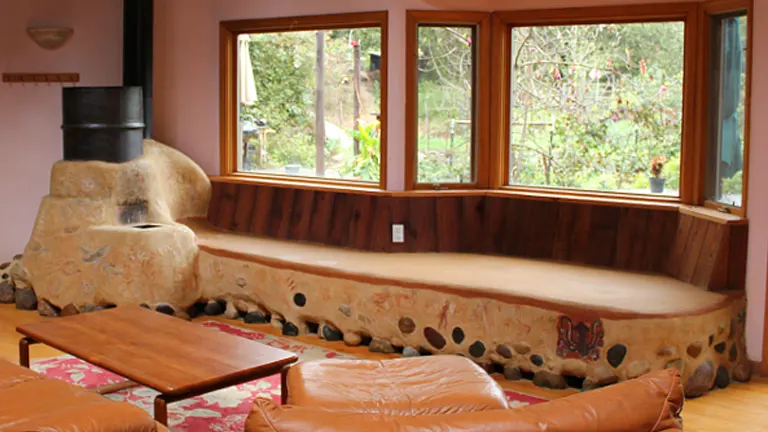
- Wood Feed: This is the gateway through which both wood and air are introduced into the system. The J-tube design features a slender wood feed that accepts wood vertically. Intricately designed, the wood feed ensures that only the lowermost parts of the wood sticks ignite. The airflow directs the fire sideways, heading toward the combustion chamber and subsequently the heat riser. This lateral fire progression curtails smoke from escaping into the environment. As the wood sticks continue to burn, they naturally progress deeper into the feed. Notably, the batch-box style heater’s wood feed can accommodate a larger volume of wood simultaneously.
- Heat Riser: Acting as the heart of the rocket mass heater, the heat riser is an insulated vertical conduit responsible for drawing flames upwards, thereby energizing the entire firebox. Insulation is paramount for the heat riser to retain high temperatures, ensuring thorough combustion. The insulating material’s low thermal conductivity aids in maintaining elevated temperatures inside the heat riser. Upon reaching the barrel that encompasses the heat riser, the hot gases release substantial heat, resulting in their cooling. This dynamic establishes a powerful convective current inside the heat riser, driving the forward airflow and consequently facilitating the sideways burning of wood in the wood feed.
- Barrel: The barrel, often with a volume of about 0.2 m^3, encapsulates the heat riser. Serving as a radiant heat source, its surface can also double up as a cooking top. To optimize the convective currents, the barrel’s construction typically employs steel or materials known for their high thermal conductivity.
- Heat Exchange Mass: This component is pivotal for transmitting the generated heat to the surroundings. Constituted by materials like cob, rocks, sand, or pebbles, this thermal mass absorbs the heat emanating from the combustion gases. Often artistically molded into a bench, the heat exchange mass doesn’t just serve a functional purpose but can also become an aesthetic centerpiece in homes.
What is Thermal Mass?
The secret behind the rocket mass heater’s efficiency is its use of a thermal mass. In simpler terms, a thermal mass is like a heat storage tank. It’s made of dense materials that can soak up, store, and slowly release heat over time.
Imagine a rock that’s been near a campfire. Even after the fire is out, the rock stays warm for a while. This is because the rock has absorbed the heat and slowly gives it off even without an active fire.
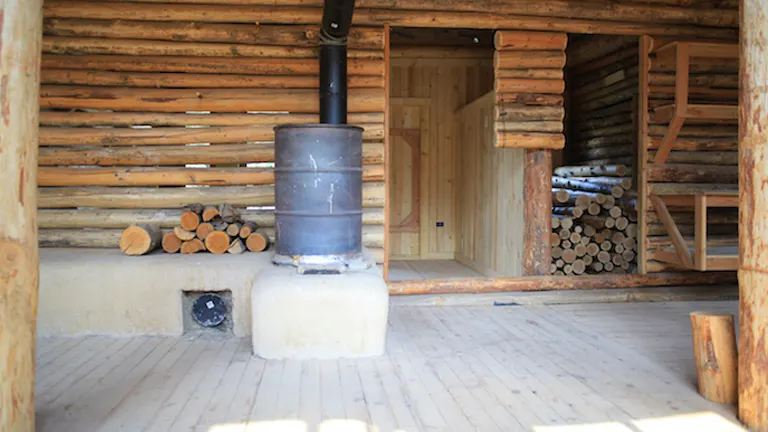
In a rocket mass heater, instead of immediately letting out all the heat, it stores much of it in the thermal mass. This means the warmth doesn’t just hit you suddenly; it’s given out slowly and consistently. This keeps the room at a comfortable temperature for longer.
Some people even design beautiful benches or beds around their heaters using materials like cob. But there’s room for creativity! Whether you’re warming up a fish pond or trying to keep plants warm in cold areas, rocket mass heaters can help. Plus, they use way less wood compared to traditional stoves, making them both efficient and eco-friendly.
Environmental Impact
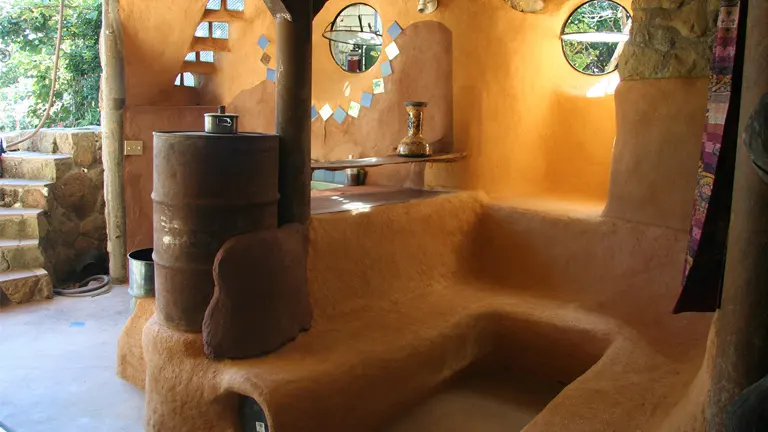
Given the emphasis on clean combustion, Rocket Mass Heaters make a substantial contribution to reducing greenhouse gas emissions. Traditional wood-burning systems have been identified as significant sources of methane and nitrous oxide emissions. By contrast, the efficient combustion technology of Rocket Mass Heaters dramatically reduces the release of these potent greenhouse gases, making them a more environmentally friendly option.
Weighing the Pros and Cons
Benefits:
- Reduced Wood Consumption: One of the significant benefits of rocket mass heaters is their efficiency. Some enthusiasts note that these heaters use only about 10% of the wood a conventional wood stove would consume.
- Superior Thermal Efficiency: Due to the heat exchange mass’s ability to absorb and distribute the combustion heat to its surroundings, rocket mass heaters often exhibit higher thermal efficiency than other heating systems.
- Lower Exhaust Temperatures: A functioning rocket mass heater typically has an exhaust temperature ranging from 60–90 °C (140–194 °F). In contrast, conventional wood stoves can produce exhaust temperatures of around 400–600 °C (752–1112 °F).
- Cleaner Exhaust Emission: Advocates suggest that the exhaust gas from a rocket mass heater primarily comprises carbon dioxide and steam. This indicates that these heaters are adept at burning fuel more efficiently than other heaters.
- Sustained Heat Release: The heat exchange mass’s low thermal transmittance ensures that heat is released gradually. Some users even state that their rocket mass heaters can keep their homes warm for days, long after the wood has burnt out and the fire has extinguished.
Disadvantages:
- Bulky Construction: Building a rocket mass heater is no small feat. The construction can be extensive, potentially dominating a significant portion of a room, particularly in smaller homes. This might make it less suitable for those with limited space or those not willing to dedicate such a large area to the heater.
Rocket Mass Heater vs. Conventional Wood Stove
At a glance, a conventional wood stove seems like a simple construction: a metal box with a chimney. The fire is kindled in the box, and the heat is drawn out immediately. With average fire temperatures around 1,000 degrees Fahrenheit, these stoves often release uncombusted particles and creosote into the chimney, leading to the risk of hazardous chimney fires.

However, let’s delve deeper into the true efficiency of conventional wood stoves. Many individuals, perhaps after seeing a “75% efficient” rating, assume their wood stoves are performing near peak potential. But there’s a misconception here. While theoretically, a wood stove might achieve 75% efficiency in controlled laboratory settings, the real-world scenario is quite different. An experienced wood stove operator might get efficiencies closer to 35%, and those using wet or green wood and restricting airflow for a “slow burn” might see dismal efficiencies as low as 5%. So, when people ask how a Rocket Mass Heater can claim to heat a home with a tenth of the wood, they’re often comparing it to the perceived efficiency of traditional stoves rather than their actual performance.
Rocket Mass Heaters radically transform this paradigm. By insulating the firebox instead of the chimney, they push combustion temperatures to over 1,800 degrees Fahrenheit. This not only ensures almost complete combustion of creosote and smoke but also keeps the exhaust at just above room temperature and at a mere trickle. The warmth is retained inside the home rather than being lost in the form of hot smoke.
To understand this in numerical terms, let’s break it down:
- The quoted “75% efficiency” often does not account for the heat that escapes up the chimney to expel smoke. Lab tests might use a figure like 14% or 16% for the smoke loss. So, a stove rated at 75% efficiency is, in reality, performing at closer to 59%.
- Furthermore, Rocket Mass Heaters lack mechanisms to reduce airflow for a slow, inefficient burn. This design ensures even an inexperienced user can achieve around 90% efficient burns consistently.
Lastly, concerns regarding creosote, a major problem with conventional wood stoves, are addressed ingeniously in Rocket Mass Heaters. In standard stoves, inefficient burning can lead to creosote accumulation in chimneys, posing a fire risk. In Rocket Mass Heaters, the “chimney” is essentially the heat riser, designed to have a controlled chimney fire with every use, preventing dangerous build-ups.
Can I Build a Rocket Mass Heater Myself?
Absolutely! The beauty of rocket mass heaters, beyond their heat efficiency, is their simplicity. Even though they’re called “rocket” stoves, you don’t need to be a rocket scientist to assemble one.
However, a word of caution: whenever you’re introducing something that involves fire inside your home, always be thorough in your research. Safety first! Thankfully, there’s a wealth of resources available, complete with expert guidance to help you safely set up an effective rocket mass heater.
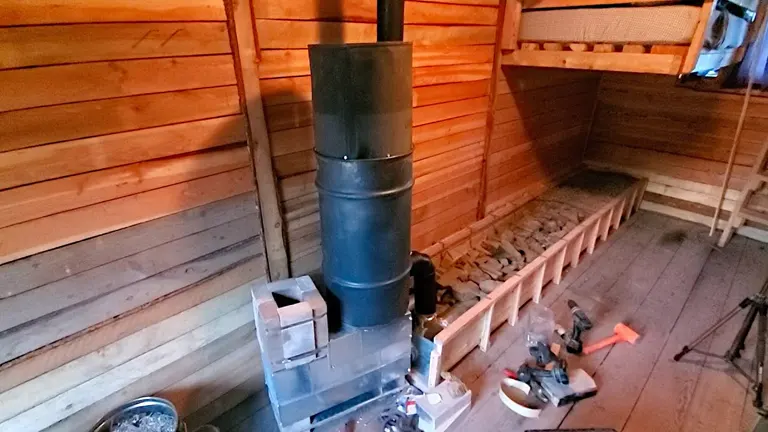
To reiterate: approach this with diligence and commitment. If you’re serious about building one, immerse yourself in understanding its workings.
Interestingly, despite their efficiency, rocket mass heaters haven’t hit the mainstream heating scene yet. This means there’s a lot of potential for enthusiasts to innovate and even collaborate with industry pioneers like Ernie and Erica Wisner and Paul Wheaton.
So, not only can you craft one for your home, but if you master the skill, who knows? Maybe you could turn it into a profession. The sky’s the limit!
Rocket Mass Heater Plans
Unlock Sustainable Heating with ‘Rocket Mass Heaters Plans’
Ready to heat your home the eco-friendly way? The ‘Better Wood Heat: DIY Rocket Mass Heaters 8-DVD Set‘ has you covered. This 8-DVD treasure from Permies offers expert guidance and step-by-step instructions for a warm, sustainable home.
Get Rocket Mass Heaters Plans now.
Link: Rocket Mass Heaters Plan
A Journey of Optimization
The journey of Rocket Mass Heaters is one of consistent evolution. The design has been refined over the years, leading to a significant reduction in wood usage and the creation of a thermo siphon to control heat dispersion. Furthermore, the heaters have been adorned with diverse designs and now promise homeowners a warm abode with just a fraction of the wood and smoke of traditional systems.
In conclusion, Rocket Mass Heaters represent a blend of traditional knowledge and modern innovation. Their design ensures maximum efficiency, minimum environmental impact, and a warm home, making them a worthy consideration for any sustainable living enthusiast.
FAQs
- What is the best material for a rocket mass heater?
The ideal materials for a rocket mass heater depend on its specific design and intended application. Commonly used materials include fire bricks for the combustion chamber due to their durability and heat resistance, steel drums for the heat riser to facilitate direct radiant heat, and cob, rocks, or pebbles for the thermal mass, which store and slowly release the heat. The choice of material should ensure longevity, safety, and efficient heat storage and transfer. - Do rocket mass heaters work?
Yes, rocket mass heaters are known for their efficiency and ability to produce a significant amount of heat with a small amount of fuel. They operate based on the principle of high-draft air intake, ensuring complete combustion, which results in more heat and less smoke. Their design aims to maximize the extraction of heat from the combustion gases, making them very efficient. - Can a rocket mass heater heat a house?
Absolutely. Many homeowners have successfully used rocket mass heaters as their primary heating source. One of the benefits of rocket mass heaters is the large thermal mass that stores heat and releases it gradually. This can keep a house warm for extended periods, even after the fire has gone out, depending on the size of the home and the design of the heater. - How many square feet can a rocket mass heater heat?
The heating capability of a rocket mass heater depends on its design, size, and the insulation and layout of the space it’s heating. A well-designed and properly sized rocket mass heater can efficiently heat spaces ranging from small rooms to larger homes of 1,000 square feet or more. Specific heating capabilities should be evaluated based on individual heater designs and home configurations. - Can a rocket mass heater heat water?
Yes, with the right design modifications, a rocket mass heater can also heat water. Some designs incorporate copper coils or other heat exchangers around the heat riser or within the thermal mass. As the heater operates, water circulates through these coils, getting heated in the process. This can provide hot water for domestic use or even support radiant floor heating systems.
We truly appreciate you taking the time to delve into the world of Rocket Mass Heaters with us. If you’ve found this information beneficial or have your own experiences and insights to share, we’d love to hear from you in the comments below. Engaging with a community of like-minded individuals can further the discourse and drive forward sustainable innovations. Thank you for reading, and we encourage you to share this article with others who might find it valuable!

David Murray
Forestry AuthorI'm David Murry, a forestry equipment specialist with a focus on chainsaw operation. With over 13 years of experience, I've honed my skills in operating and maintaining a wide range of machinery, from chainsaws to log splitters. My passion for the outdoors and commitment to sustainable forestry drive my work, which emphasizes safety, efficiency, and staying updated with industry advancements. Additionally, I'm dedicated to sharing my expertise and promoting environmental awareness within the forestry community.
10 comments
Hallo, sehr gut wo bekomme ich Händler nachweise und Bauanleitung. Viele Grüße Georg
Georg Goldbrunner
November 5, 2023 4:45 pmIch hoffe nur das es mit den deutschen Behörden , Schornsteinfeger, usw. Keine Schwierigkeiten gibt.
Fritz Kutz
November 2, 2023 12:58 amWo bekomme ich Unterlagen für den Bau und Betrieb eines solchen Ofens her.
Fritz Kutz
November 2, 2023 12:53 amBitte um Info Material.....und Info mit was ca. an kosten eingeplant werden muss . Danke im voraus Wagner
Wagner
November 2, 2023 7:22 amBitte Prospekt senden und Händler verzeichnis
Kaiser
November 1, 2023 1:00 pmWonderful innovative technology. When will our building code allow this in a home built in a city in Canada?
Joe Gallant
October 31, 2023 7:15 pmI've been studying about these units for years. Having read and watched countless videos on their construction and use I've no doubt that they work. I've been contemplating building one but size and construction limits in my home have hindered making my plan a reality. Thank you for the article as it rekindled my desire.
David
October 31, 2023 2:01 pmHow does this vent. I have a two story house and would like to put it in the basement. Thanks.
John
October 30, 2023 11:17 pmThis is such an exciting development. Living in the Highlands, we are always looking for efficient heating. A rocket mass heater might be the way forward.

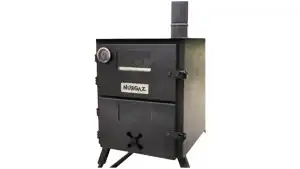


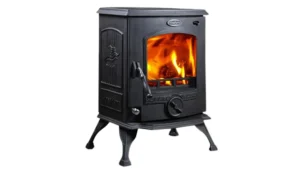

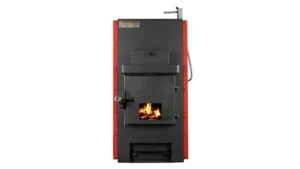

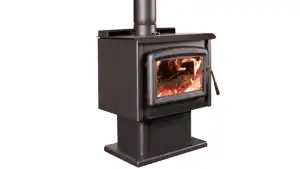
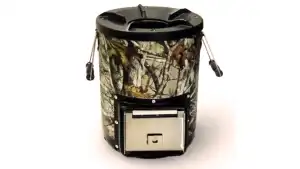



Sehr geehrte Damen und Herren, ich interessiere mich für dieses Wärmegewinnungssystem, könnten Sie mir Infomaterial und eine Händlerliste zukommen lassen. Vielen Dank vorab.
Zweigle,Karl-Heinz Zweigle
December 6, 2023 1:29 pm